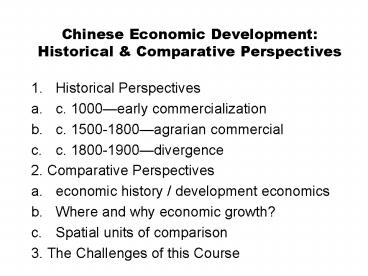Chinese Economic Development: Historical - PowerPoint PPT Presentation
1 / 20
Title:
Chinese Economic Development: Historical
Description:
economic history / development economics. Where and why economic growth? ... institutional mixes by region?elative importance of formal and informal, e. ... – PowerPoint PPT presentation
Number of Views:42
Avg rating:3.0/5.0
Title: Chinese Economic Development: Historical
1
Chinese Economic DevelopmentHistorical
Comparative Perspectives
- Historical Perspectives
- c. 1000early commercialization
- c. 1500-1800agrarian commercial
- c. 1800-1900divergence
- 2. Comparative Perspectives
- economic history / development economics
- Where and why economic growth?
- Spatial units of comparison
- 3. The Challenges of this Course
2
Historical Perspectives1000 ADcommercialized
economy in Jiangnan
- Growth of market towns (brokers, shops, urban
culture of story tellers, theatre, tea houses) - Growth of long-distance trade (boats, docks)
- Specialized agricultural production, cash crops
- Handicraftstextiles, silk and cotton.
3
1500-1800 continued spread of
commercialized agrarian economy
- Rural handicrafts supplement agriculture
- 2 contrasts with Europe
- Rural crafts and agriculture separate
- More crafts go to cities
- Chinese features
- Long-distance trade, areal specialization
increased marketing--urban-rural connections AND
connections between regions of empire - More isolated peripheral areas have some markets
and exchange differ in resource endowments.
4
Economic ties beyond the empire
- Silver imports and commercial change
- Trade w/ Southeast and Northeast Asiasilks,
teas, porcelains, foodstuffs, medicines - Trade through Central Asiaprecious jewels
stones, paper, silk, - Trade with Europe-- silks, teas, porcelains
5
19th-c. Divergence
- Europe industrializes/China population pressures
and environmental challenges grow - Changed trade connectionsprimary products
exports, Europeans do import substitution on
porcelain and silk - But variations within China Europe too
- Key differences technology institutions
6
20th-c. Changes in China
- Pockets of industrialization
- Agrarian crisis
- Growing divide between rural and urban
- Greater regional variations
- Questions of whether positive or negative changes
to spread faster - Key role of unstable political situation
7
Chinas economy in 1949
- Short-run
- recovery from war and occupation
- restore social and economic order
- Long-run
- industry in certain areas
- rural stability
- questions about urban-rural relations and
development path
8
Chinas Past its Economic Future
- Re-establish strong centralized state, unified
and integrated control - Managing agrarian economic and social order a
major political job - See industrial economy largely for state
strengthwealth and power of late 19th c forward
9
Comparative Perspectives
- economic history / development economics
- Where and why economic growth?
- Spatial units of comparison
10
Sources of Growth
- Division of labor, increased market size,
economies of scale - Savings/investment vs consumption
- Organizational change for increased efficiency
- Technological change
11
Economic History
- Study of how economies have grown historically
application of economic theory and principles to
past practices - Most developed literature for Western Europe and
the United States - How to fit in cases with less clear paths of
growthe.g. Africa, Asia and Latin America?
12
Development Economics
- Assume we know how to create growth
- Growth based on the shift from traditional to
modern sectorindustrialization. - Industrial policies create conditions for
private or nationalized industry, varying roles
for government - Macroeconomic policies to promote market
development and stability.
13
Explaining vs creating growth
- Intentions and complexitygap between
theory/policies and implementation - Unintended consequences
- Consequences of European states needing
loansdevelop banking - Consequences of early modern European
warmanufacturing into cities - 1950s Chinese government control of resource and
product flows to avoid monopoly markets, makes
all movements difficult
14
Where and why economic growth?
- Euro-America has a range of paths
- Capital-intensive industrialization
- Initially market led but late 19th c. increasing
roles for state - Asia has overlapping sequence of paths--
- Japan and China in early 20th c. are labor
intensive methods - Post WW II heavy industrialization with state set
priorities.
15
Who industrialized, how why?
- At end of WW II, outside of Euro-America and
Japan, Argentina, Brazil, Chile, China, Korea,
Malaysia, Mexico, India, Indonesia, Taiwan,
Thailand and Turkey. - Development economics fails to explain or create
successes. Cannot model increasing returns to
scale or oligopolistic behavior. Result lack of
formal models to make clear causal mechanisms.
Politics matter.
16
National units of comparison
- Large and small countries cannot be compared just
with arithemetic averages - Variation within large national units and
explanations of differenceswhich variables are
the same within a large country and across
several small ones? - Politically defined spaces matter but how has to
be carefully evaluated.
17
The role of institutions in defining economic
regions within and beyond national states
- Common institutions to create a region e.g.,
contract law - Institutions that link otherwise different sets
of institutionsfinancial markets between
institutionally different economies - Alternative institutional mixes by
regionrelative importance of formal and
informal, e.g. litigation versus mediation
18
Comparisons and connections
- States have policies that affect growth
- Connections in the international economic system
shape growth - Two questions
- The relative importance of economic connections
within regions or across the globe - The relative importance of paths of development
vs systems within which development takes place
19
Course challenges
- locate Chinas developments since 1978 in global
context - compare with other paths of development
- note spatial scales of variation
- Observe particular institutional complexes
20
Course goals
- Establish contexts China in 1950s isolated
growth is largely a domestic issue China by 2000
increasingly connected to international
networksdo connections mean greater
similarities? - Observe bottom up and top down patterns of change
and their social consequences - Locate Chinas pattern of changes in world time
and space





![❤[READ]❤ The East is Still Red - Chinese Socialism in the 21st Century PowerPoint PPT Presentation](https://s3.amazonaws.com/images.powershow.com/10046644.th0.jpg?_=202406030411)

























